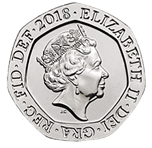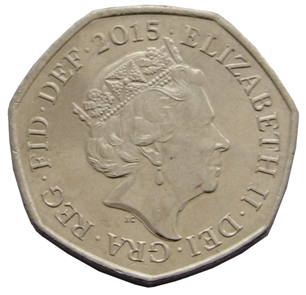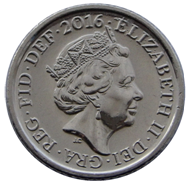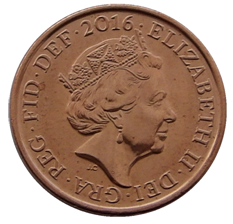G

- Saint George (died 303)
- 1817–: Gold sovereign. [17]
- 1817–: Half sovereign.
- 2009–: Quarter sovereign.
This is a list of people who have appeared on coins of the United Kingdom. The reigning monarch appears on the obverse of all coins, thus most of these listed were on the reverse. Names and titles listed are those of the person when the coin was struck, or on their death, whichever was first. The list does not include the national effigy Britannia who has featured on many circulated, commemorative and bullion coins.
As he is the current Monarch, his portrait will appear on the obverse of all coins, starting with a 2022 50p commemorating the death of Queen Elizabeth II.


The standard circulating coinage of the United Kingdom, British Crown Dependencies and British Overseas Territories is denominated in pennies and pounds sterling, and ranges in value from one penny sterling to two pounds. Since decimalisation, on 15 February 1971, the pound has been divided into 100 (new) pence. Before decimalisation, twelve pence made a shilling, and twenty shillings made a pound.

Royal Maundy is a religious service in the Church of England held on Maundy Thursday, the day before Good Friday. At the service, the British monarch or a royal official ceremonially distributes small silver coins known as "Maundy money" as symbolic alms to elderly recipients. The coins are technically legal tender, but typically do not circulate due to their silver content and numismatic value. A small sum of ordinary money is also given in lieu of gifts of clothing and food that the sovereign once bestowed on Maundy recipients.

The British decimal twenty pence coin is a denomination of sterling coinage worth 1/5 of a pound. Like the 50p coin, it is an equilateral curve heptagon. Its obverse has featured the profile of Queen Elizabeth II since the coin's introduction on 9 June 1982. Four different portraits of the Queen have been used; the latest design by Jody Clark was introduced in 2015. The second and current reverse, featuring a segment of the Royal Shield, was introduced in 2008.

The British decimal fifty pence coin is a denomination of sterling coinage worth one half of a pound. Its obverse features the profile of the current Monarch since the coin's introduction in 1969. As of October 2022, five different royal portraits have been used.

The British decimal five pence coin is a denomination of sterling coinage worth five one-hundredths of a pound. Its obverse has featured the profile of Queen Elizabeth II since the coin’s introduction on 23 April 1968, replacing the shilling in preparation for decimalisation in 1971. It remained the same size as the one shilling coin, which also remained legal tender, until a smaller version was introduced in June 1990 with the older coins being withdrawn on 31 December 1990. Four different portraits of the Queen have been used, with the latest design by Jody Clark being introduced in 2015. The second and current reverse, featuring a segment of the Royal Shield, was introduced in 2008.

The British decimal one penny (1p) coin is a unit of currency and denomination of sterling coinage worth one-hundredth of one pound. Its obverse has featured the profile of Queen Elizabeth II since the coin's introduction on 15 February 1971, the day British currency was decimalised. Four different portraits of the Queen have been used on the obverse; the latest design by Jody Clark was introduced in 2015. The second and current reverse, designed by Matthew Dent, features a segment of the Royal Shield and was introduced in 2008. The penny is the lowest value coin ever to circulate in the United Kingdom.

The British decimal two pence coin is a denomination of sterling coinage equalling 2/100ths of a pound. Since the coin's introduction on 15 February 1971, the year British currency was decimalised, its obverse has featured four profiles of Queen Elizabeth II. In 2008 the design on its reverse changed from the original depiction of a plume ostrich feathers with a coronet to a segment of the Royal Shield.

The British one pound (£1) coin is a denomination of sterling coinage. Its obverse bears the Latin engraving ELIZABETH II D G REG F D meaning, 'Elizabeth II, by the grace of God, Queen, Defender of the Faith'. It has featured the profile of Queen Elizabeth II since the original coin's introduction on 21 April 1983. Four different portraits of the Queen have been used, with the latest design by Jody Clark being introduced in 2015. The design on the reverse side of the current, 12-sided coin features four emblems to represent each of the nations of the United Kingdom — the English rose, the leek for Wales, the Scottish thistle, and the shamrock for Northern Ireland, also two or three oak leaves — emerging from a single 5-branched stem within a crown. In May 2022 the Royal Mint announced that the Kenyan-born artist Michael Armitage is designing a new £1 coin which will be issued in 2023 and will celebrate the "history of the UK in the 21st century".
The British five pound (£5) coin is a commemorative denomination of sterling coinage. As of October 2022, the obverse of new coins feature the profile of King Charles III. The obverse previously depicted Queen Elizabeth II between the coin's introduction in 1990 and the Queen's death in 2022. Two different portraits of the Queen graced the coin, with the last design by Ian Rank-Broadley being introduced in 1998. The coin has no standard reverse; instead it is altered each year to commemorate important events. Variant obverses have also been used on occasion.

Ian Rank-Broadley FRBS is a British sculptor who has produced many acclaimed works, among which are several designs for British coinage and the memorial statue of Princess Diana at Kensington Palace in London unveiled on her 60th birthday in 2021.

The British florin, or two-shilling piece was a coin worth 1⁄10 of one pound, or 24 pence. It was issued from 1849 until 1967, with a final issue for collectors dated 1970. It was the last coin circulating immediately prior to decimalisation to be demonetised, in 1993, having for a quarter of a century circulated alongside the ten-pence piece, identical in specifications and value.

The British threepence piece, usually simply known as a threepence, thruppence, or thruppenny bit, was a denomination of sterling coinage worth 1⁄80 of one pound or 1⁄4 of one shilling. It was used in the United Kingdom, and earlier in Great Britain and England. Similar denominations were later used throughout the British Empire and Commonwealth countries, notably in Australia, New Zealand and South Africa.
The five pound gold coin is a British coin with a nominal value of five pounds sterling, produced in several periods since the early 19th century. Since 1990 it is also known as the five-sovereign piece or quintuple sovereign as it is equivalent to five sovereign coins and shares the alloy and design features of the sovereign.

The British crown was a denomination of sterling coinage worth 1/4 of one pound, or 5 shillings, or 60 (old) pence. The crown was first issued during the reign of Edward VI, as part of the coinage of the Kingdom of England.

The sovereign is a British gold coin with a nominal value of one pound sterling (£1) and contains 0.2354 troy oz of pure gold. Struck since 1817, it was originally a circulating coin that was accepted in Britain and elsewhere in the world; it is now a bullion coin and is sometimes mounted in jewellery. In addition, circulation strikes and proof examples are often collected for their numismatic value. In most recent years, it has borne the design of Saint George and the Dragon on the reverse; the initials of the designer, Benedetto Pistrucci, are visible to the right of the date.
The pound is the currency of Guernsey. Since 1921, Guernsey has been in currency union with the United Kingdom and the Guernsey pound is not a separate currency but is a local issue of sterling banknotes and coins, in a similar way to the banknotes issued in Scotland, England and Northern Ireland. It can be exchanged at par with other sterling coinage and notes.
The pound was the currency of the Gambia between 1965 and 1971. Gambia used the British West African pound until it issued its own currency on October 5, 1964. In 1971, the dalasi replaced the pound at a rate of £1 = D5. 1 pound was made up of 20 shillings, each shilling consisting of 12 pence.
The coins of Canada are produced by the Royal Canadian Mint and denominated in Canadian dollars ($) and the subunit of dollars, cents (¢). An effigy of the reigning monarch always appears on the obverse of all coins. There are standard images which appear on the reverse, but there are also commemorative and numismatic issues with different images on the reverse.
Commemorative coins have been issued by the Royal Mint in the United Kingdom since 1935. Initially they only came out to mark events of great interest, but since the turn of the millennium have been minted yearly.